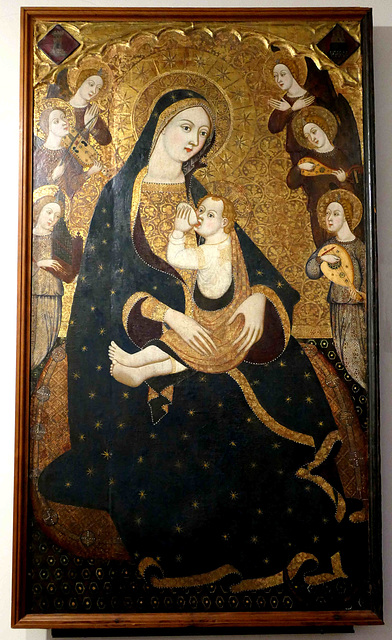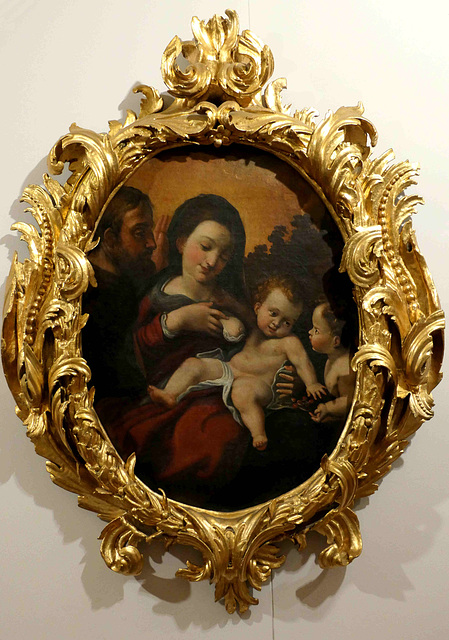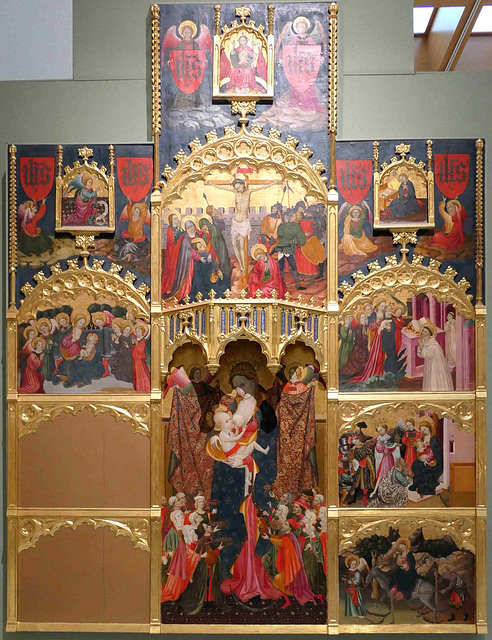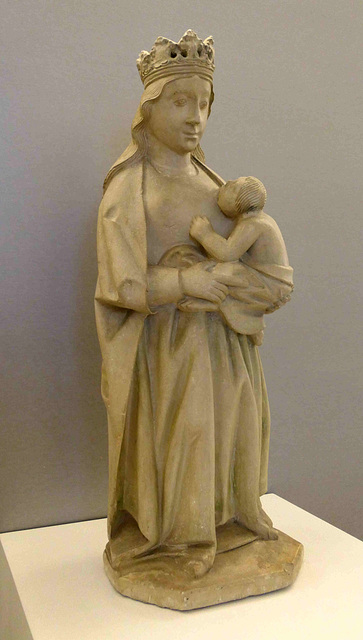
Maria lactans
The nursing Madonna is an iconography of the Madonna and Child in which Mary is depicted nursing the infant Jesus. It is a very popular image, because noble women usually had wet nurses.
Madrid - Museo Thyssen-Bornemisza
Madrid is the capital and most populous city of Spain. The city has almost 3.4 million inhabitants and a metropolitan area population of approximately 6.7 million. Madrid is part of the historical landscape of Castile and is located in the middle of the Meseta, the plateau of Castile.
The site has been occupied since prehistoric times. The first document about the existence of an established settlement in Madrid dates from the Muslim age. In the second half of the 9th century Umayyad Emir Muhammad I built a fortress here. In 1083, Madrid was conquered by the Kingdom of Castile. In 1309, under Fernando IV, the Assembly of Estates (Cortes) of the Kingdom of Castile was convened for the first time in Madrid.
In 1561, Philip II moved the royal court from Valladolid to Madrid. It became the de facto capital of Spain, which it remains to this day. The War of the Spanish Succession ended in 1714 with the Bourbons taking over the Spanish throne. Today's royal palace was built under their rule. Particularly during the reign of Charles III the city's public infrastructure was modernized and numerous public buildings were built.
Museo Thyssen-Bornemisza
The museum is named after its founder, Baron Heinrich Thyssen-Bornemisza. With over 1,600 paintings, it was once the second-largest private collection in the world.
After Baron Thyssen, having unsuccessfully sought permission to enlarge his museum in Lugano, searched for a better-suited location elsewhere in Europe end of the 1980s. In 1985, the Baron had married Carmen "Tita" Cervera and introduced her to art collecting. Cervera's influence was decisive in persuading the Baron to relocate the core of his collection to Spain where the local government had a building available next to the Prado. The Thyssen-Bornemisza Museum officially opened in 1992, showing 715 works of art. A year later, the Spanish Government bought 775 works for $350 million.These pieces are now in the purpose-built museum in Madrid. After the museum opened, in 1999, Cervera loaned 429 works of her own art collection to the museum for 11 years. The loan was renewed annually for free from 2012.
Anonym Dutch Master / first half 16th century
Cuenca - Catedral de Santa María y San Julián
When the Muslims conquered the area in 714, they recognized the value of this strategic location and built a fortress between two ravines.
In 1076, Cuenca was unsuccessfully besieged by Sancho Ramírez of Aragon. In 1080 there was a treaty between King Yahya al-Qadir and Alfonso VI. of León and Castile, through which some fortresses were ceded in exchange for military aid.
Cuenca was then conquered by Al-Mu'tamid ibn Abbad in 1086. However, when his country was attacked by the Almoravids, he again offered Cuenca to Alfonso in return for military support. The first Christian troops entered the city in 1093. However, the Almoravids conquered it in 1108. As part of the Reconquista, King Alfonso VIII conquered the city from the Moors in 1177 after a nine-month siege. The Diocese of Cuenca was founded in 1183. Alfonso X gave Cuenca the title “ciudad” in 1257.
Cuenca is divided into two different areas, the Old Town and the New Town. The first is located on a rocky hill bordered on the north by the gorges of the Júcar River and on the south by its tributary, the Huécar River. Cuenca is a vibrant city with a population of about 55.000.
The Cathedral, inspired by the early Gothic architecture of Central Europe (Soissons, Laon...), was built between 1196 and 1257, but many changes were made repeatedly in the following centuries. The entire choir area was renovated in the 15th century, and the decor of the apse were only created in the 17th/18th century.
In 1902, the bell tower collapsed after a lightning strike and damaged the facade, whose reconstruction in the neo-Gothic style, which was not true to the original, began eight years later. The current appearance shows that the structure remains unfinished.
Two Saints flank a "Maria lactans"
Valencia - Catedral de Santa María
According to the Roman historian Titus Livius "Valentia" was founded by Consul Decimus Iunius Brutus Callaicus in the 4th century BC.
A century later "Valentia Edetanorum" became one of the first Hispanic cities to become a Roman colony.
The city made rapid progress after the Arab conquest in 711, reaching 15,000 inhabitants in the Caliphate of Córdoba. The Amirids and the Dhun Nunids ruled in “Balansiya”. In 1094, El Cid, a Castilian noble, conquered the city. The conquest was not carried out on behalf of one of the Christian kingdoms, but on the Cid's own account, who proclaimed himself "Señor de Valencia" and thus created a kind of private kingdom. He was able to defend the city against several Almoravid attacks, and after his death in 1099, his widow Jimena managed to hold Valencia until 1102, when it fell to the Almoravids, and a little later to the Almohads.
After the victory of the united Christian armies over the Almohads in the Battle of Las Navas de Tolosa (1212), Moorish Spain fell apart again into individual small kingdoms, including a Taifa from Valencia.
It was finally conquered in 1238 by Jaime I de Aragón (aka "el Conquistador"), after a five-month siege.
In the 15th century, the city grew rapidly and developed into one of the largest Mediterranean ports and an important trade and financial center. At the beginning of the 15th century the city had around 40,000.
There was once a Roman temple on the site of the church, which was converted into a Visigothic church after the Muslim conquest and converted into a mosque. After the reconquest in 1237, it became a church again.
The construction of the current Gothic-style building began in 1262 and was completed in the 15th century. However, its construction went on for centuries, so there is a mixture of Renaissance, Baroque, and Classicism styles.
Virgen de la Humildad / 14th century /
"Maria lactans"
Valencia - Catedral de Santa María
According to the Roman historian Titus Livius "Valentia" was founded by Consul Decimus Iunius Brutus Callaicus in the 4th century BC.
A century later "Valentia Edetanorum" became one of the first Hispanic cities to become a Roman colony.
The city made rapid progress after the Arab conquest in 711, reaching 15,000 inhabitants in the Caliphate of Córdoba. The Amirids and the Dhun Nunids ruled in “Balansiya”. In 1094, El Cid, a Castilian noble, conquered the city. The conquest was not carried out on behalf of one of the Christian kingdoms, but on the Cid's own account, who proclaimed himself "Señor de Valencia" and thus created a kind of private kingdom. He was able to defend the city against several Almoravid attacks, and after his death in 1099, his widow Jimena managed to hold Valencia until 1102, when it fell to the Almoravids, and a little later to the Almohads.
After the victory of the united Christian armies over the Almohads in the Battle of Las Navas de Tolosa (1212), Moorish Spain fell apart again into individual small kingdoms, including a Taifa from Valencia.
It was finally conquered in 1238 by Jaime I de Aragón (aka "el Conquistador"), after a five-month siege.
In the 15th century, the city grew rapidly and developed into one of the largest Mediterranean ports and an important trade and financial center. At the beginning of the 15th century the city had around 40,000.
There was once a Roman temple on the site of the church, which was converted into a Visigothic church after the Muslim conquest and converted into a mosque. After the reconquest in 1237, it became a church again.
The construction of the current Gothic-style building began in 1262 and was completed in the 15th century. However, its construction went on for centuries, so there is a mixture of Renaissance, Baroque, and Classicism styles.
The original was painted by
. This "Sagrada Familia" is a copy painted in the 17th century.
Maria lactans
Valencia - Museo de Bellas Artes
According to the Roman historian Titus Livius "Valentia" was founded by Consul Decimus Iunius Brutus Callaicus in the 4th century BC.
A century later "Valentia Edetanorum" became one of the first Hispanic cities to become a Roman colony.
The city made rapid progress after the Arab conquest in 711, reaching 15,000 inhabitants in the Caliphate of Córdoba. The Amirids and the Dhun Nunids ruled in “Balansiya”. In 1094, El Cid, a Castilian noble, conquered the city. The conquest was not carried out on behalf of one of the Christian kingdoms, but on the Cid's own account, who proclaimed himself "Señor de Valencia" and thus created a kind of private kingdom. He was able to defend the city against several Almoravid attacks, and after his death in 1099, his widow Jimena managed to hold Valencia until 1102, when it fell to the Almoravids, and a little later to the Almohads.
After the victory of the united Christian armies over the Almohads in the Battle of Las Navas de Tolosa (1212), Moorish Spain fell apart again into individual small kingdoms, including a Taifa from Valencia.
It was finally conquered in 1238 by Jaime I de Aragón (aka "el Conquistador"), after a five-month siege.
In the 15th century, the city grew rapidly and developed into one of the largest Mediterranean ports and an important trade and financial center. At the beginning of the 15th century the city had around 40,000.
The "Museo de Bellas Artes" was founded in 1913 and is located in the St. Pius V Palace, built in the 17th–18th centuries.
Antoni Peres / doc in Valencia 1393- 1423 /
Altarpiece of the Life of the Virgin
Valencia - Museo de Bellas Artes
According to the Roman historian Titus Livius "Valentia" was founded by Consul Decimus Iunius Brutus Callaicus in the 4th century BC. A century later "Valentia Edetanorum" became one of the first Hispanic cities to become a Roman colony.
The city made rapid progress after the Arab conquest in 711, reaching 15,000 inhabitants in the Caliphate of Córdoba. The Amirids and the Dhun Nunids ruled in “Balansiya”. In 1094, El Cid, a Castilian noble, conquered the city. The conquest was not carried out on behalf of one of the Christian kingdoms, but on the Cid's own account, who proclaimed himself "Señor de Valencia" and thus created a kind of private kingdom. He was able to defend the city against several Almoravid attacks, and after his death in 1099, his widow Jimena managed to hold Valencia until 1102, when it fell to the Almoravids, and a little later to the Almohads.
After the victory of the united Christian armies over the Almohads in the Battle of Las Navas de Tolosa (1212), Moorish Spain fell apart again into individual small kingdoms, including a Taifa from Valencia.
It was finally conquered in 1238 by Jaime I de Aragón (aka "el Conquistador"), after a five-month siege.
In the 15th century, the city grew rapidly and developed into one of the largest Mediterranean ports and an important trade and financial center. At the beginning of the 15th century the city had around 40,000.
The "Museo de Bellas Artes" was founded in 1913 and is located in the St. Pius V Palace, built in the 17th–18th centuries.
Maestro de Perea / doc in Valencia end of 14th c /
The Virgin of the Millers´ Guild
Viseu - Museu de Arte Sacra
Chief Viriathus ("Viriato") successfully led the Lusitanians here in their resistance against the advancing Romans in the second century BC, until the latter were able to kill Viriathus and also conquer this area. Various milestones of Roman roads crossing here have been preserved. After the invasion of the Suebi and Visigoths in the 6th century AD, Viseu became a bishop's see.
From the beginning of the 8th century, the region was ruled by Moors. During the Reconquista, Viseu also remained contested. In 1027, King Alfonso V of León fell during the siege of Viseu. Ferdinand I of León was finally able to conquer the region from the Arabs in 1057.
Archaeological research has shown that there was an early Christian basilica on the site of Viseu Cathedral, which was built during the time of Suevian rule (5th-6th century), as Pope John III had already established a bishopric here in 572.
After the reconquista, a first church was built from 1094 to 1114 on the site of today's cathedral. The new cathedral was built between 1289 and 1313 under King Dinis I, and the first cloister was added in 1379. The main portal of the cathedral was built in 1513.
The Museu de Arte Sacra is housed in the complex of Viseu Cathedral.
N.Sra do Leite - Our Lady of Milk / 15th century
Jump to top
RSS feed- Latest items - Subscribe to the latest items added to this album
- ipernity © 2007-2024
- Help & Contact
|
Club news
|
About ipernity
|
History |
ipernity Club & Prices |
Guide of good conduct
Donate | Group guidelines | Privacy policy | Terms of use | Statutes | In memoria -
Facebook
Twitter








